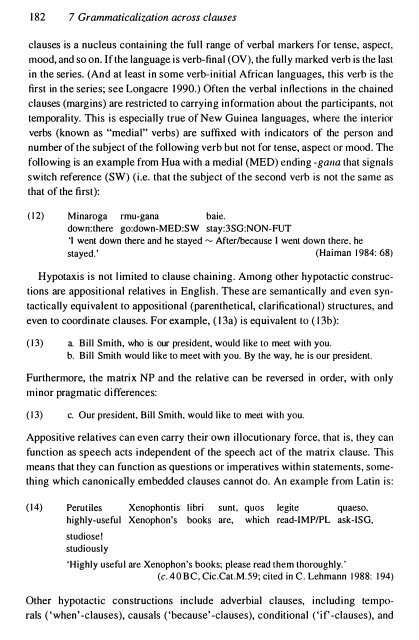Gram - SEAS
Gram - SEAS
Gram - SEAS
You also want an ePaper? Increase the reach of your titles
YUMPU automatically turns print PDFs into web optimized ePapers that Google loves.
182 7 <strong>Gram</strong>maticalization across clauses<br />
clauses is a nucleus containing the fu ll range of verbal markers for tense, aspect,<br />
mood, and so on. If the language is verb-final (OV), the fully marked verb is the last<br />
in the series. (And at least in some verb-initial African languages, this verb is lhe<br />
first in the series; see Longacre 1990.) Often the verbal inl1ections in the chained<br />
clauses (margins) are restricted to carrying information aboul the participants, not<br />
temporality. This is especially true of New Guinea languages, where the inlerior<br />
verbs (known as "medial" verbs) are suffixed with indicators of the person and<br />
number of the subject of the following verb but not for tense, aspect or mood. The<br />
following is an example from Hua with a medial (MED) ending -galla lhat signals<br />
switch reference (SW) (i.e. that the subject of the second verb is not the same as<br />
that of the first):<br />
(12) Minaroga rmu-gana baie.<br />
down:lhere go:down-MED:SW stay:3SG:NON-FUT<br />
'\ went down there and he stayed After/because \ went down there. he<br />
stayed.' (Haiman 1984: 68)<br />
Hypotaxis is not limited to clause chaining. Among other hypotactic constructions<br />
are appositional relatives in English. These are semantically and even syntactically<br />
equivalent to appositional (parenthetical, c1arificational) structures, and<br />
even to coordinate clauses. For example, (13a) is equivalent to (13b):<br />
(13) a. Bill Smith, who is our president, would like to meet with you.<br />
b. Bill Smith would like to meet with you. By the way, he is our president.<br />
Furthermore, the matrix NP and the relative can be reversed in order, with only<br />
minor pragmatic ditTerences:<br />
(13) c. Our president, Bill Smith, would like to meet with you.<br />
Appositive relatives can even carry their own iIIocutionary force. that is, they can<br />
fu nction as speech acts independent of the speech act of the matrix clause. This<br />
means that they can function as questions or imperatives within statements, something<br />
which canonically embedded clauses cannot do. An example from Latin is:<br />
(14) Perutiles Xenophontis Iibri<br />
highly-useful Xenophon's books<br />
studiose!<br />
studiously<br />
sunt. quos legite quaeso.<br />
are, which read-IMP/PL ask-ISG.<br />
'Highly useful are Xenophon's books; please read them thoroughly.'<br />
(c. 40 BC. Cic.Cat.M.59; cited in C. Lehmann 1988: 194)<br />
Other hypotactic constructions include adverbial clauses, including temporals<br />
('when' -clauses), causals ('because' -clauses), conditional ('if' -clauses), and
















